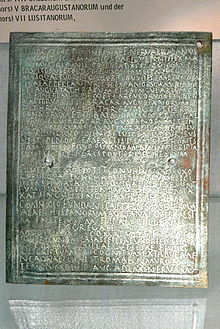Cohors II Raetorum (Raetia)
The Cohors II Raetorum ( German 2nd cohort of the Raetians ) was a Roman auxiliary unit . It is evidenced by military diplomas , inscriptions and brick stamps.
Name components
- Cohors : The cohort was an infantry unit of the auxiliary troops in the Roman army .
- II : The Roman number stands for the ordinal number, the second ( Latin secunda ). Hence the name of this military unit is pronounced as Cohors secunda ...
- Raetorum : the Rhaetians . The soldiers of the cohort were during installation of the unit from the people of Rhaetians in the area of the Roman province Raetia recruited. According to Tacitus, the Raetians' auxiliary troops were set up at two different times: after the conquest of Raetia around 15 BC. And around 70 AD as a result of the Helvetian uprising.
Since there are no references to the additions milliaria (1000 men) and equitata (partly mounted), it can be assumed that it is a pure infantry cohort, a Cohors (quingenaria) peditata . The nominal strength of the unit was 480 men, consisting of 6 Centuries with 80 men each.
history
The first reliable evidence of unity in the province of Raetia is based on a military diploma dated to the year 107 AD. In the diploma, the cohort is listed as part of the troops (see Raetian Army ) that were stationed in the province. Further diplomas, dated 116 to 167/168, prove unity in the same province.
Locations
The locations of the cohort in Raetia were:
- Sorviodurum ( Straubing ): the unit built Fort IV from 86 to 107 and remained stationed there until it was destroyed in the Marcomann Wars.
Members of the cohort
The following members of the cohort are known.
Commanders
|
|
Others
See also
Web links
Remarks
- ↑ a b The diploma is incomplete. The commander and the discharged soldier belonged to either the Cohors I Raetorum or the Cohors II Raetorum .
- ↑ a b The exact assignment to one of the two units with the name Cohors II Raetorum is not possible or is controversial.
- ↑ a b c d It is not possible to assign these soldiers to a specific unit. They could have served in the Cohors II Raetorum , the Cohors I Flavia Canathenorum or the Cohors II Gallorum , all of which were stationed in Straubing.
Individual evidence
- ↑ a b c d Farkas István Gergő: The Roman Army in Raetia , dissertation, University of Pécs Faculty of Humanities 2015, pp. 158, 160–161, 244–259, 424–423 ( PDF ).
- ^ Jörg Scheuerbrandt : Exercitus. Tasks, organization and command structure of Roman armies during the imperial era. Dissertation, Albert-Ludwigs-Universität Freiburg im Breisgau 2003/2004, p. 160 table 4 ( PDF p. 162 ).
- ^ A b John Spaul: Cohors² The evidence for and a short history of the auxiliary infantry units of the Imperial Roman Army , British Archaeological Reports 2000, BAR International Series (Book 841), ISBN 978-1-84171-046-4 , p 274-275, 279
- ↑ Military diplomas of the years 107 ( CIL 16, 55 ), 116 ( RMD 3, 155 , RMD 4, 229 ), 117/138 ( RMD 4, 256 ), 119/135 ( RMD 1, 25 ), 138/140 ( RMD 2, 94 ), 139/140 ( RMD 3, 164 ), 147 ( CIL 16, 94 ), 149/161 ( RMD 1, 59 ), 151/170 ( RMD 1, 51 ), 154/161 ( CIL 16, 117 , RMD 3, 175 ), 156 ( CIL 16, 183 ), 157 ( RMD 3, 170 , RMD 4, 275 , RMM 38 ), 157/161 ( RMD 5, 434 ), 160 ( RMD 4, 278 ), 161/163 ( RMD 2, 112 ), 161/168 ( CIL 16, 125 ), 162 ( CIL 16, 118 ), 166 ( CIL 16, 121 ) and 167/168 ( RMD 1, 68 ).
